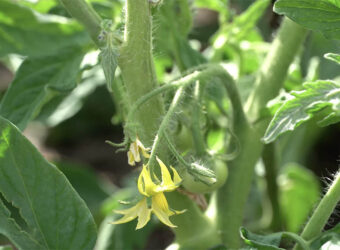The best tomatoes are homegrown. If you are considering growing your own tomatoes, you may wonder how much sunlight to give them. This guide explains how much sun tomato plants need.
How Much Sun Do Tomato Plants Need?
Tomatoes need to be planted in full sun. They need at least six hours of sunlight a day.
What Kind of Light Do Tomatoes Need?
Tomatoes need direct sunlight. They do best with morning sun and afternoon shade. Make sure there are at least six hours of sun before the shade starts.
Sunlight Requirements at Different Tomato Growth Stages
All tomato plants need at least six hours of sunlight a day, whether they are seedlings, growing vines, or fruiting vines. Tomatoes need sunlight to ripen on the vine. Seedlings may benefit from more shade than older plants as long as they get at least six hours of sunlight a day.
Sunlight Requirements for Indoor Tomato Plants
Indoors, tomato plants need to be in bright light near a window. You can also use a fluorescent light that is at least 100 watts or an LED equivalent. Whether you use natural light or artificial light, make sure the tomatoes get at least six hours of light a day. Direct sun can damage the tomato plant and tomatoes, so put the plant in bright light, not direct sun.
What Happens If Tomatoes Don’t Get Enough Sun?
Tomato plants without at least six hours of sunlight are stunted and grow poorly. They may not bloom or only have a few blooms. If they have tomatoes, the tomatoes will be small and flavorless. Tomato plants in full shade will die.
What Happens If Tomatoes Get Too Much Sun?
Tomato vines can take as much sun as they can get. If the sun is hot, tomato vines dry out faster, and the edges of the leaves turn brown. This is caused by dry soil, not heat. With adequate water, the tomato plants will survive.
Tomatoes can get sunscald if they get too much sun. Normally, the leaves shade the tomatoes some of the time and keep them from getting sunscald. If the leaves have been eaten or have fallen, the tomato can get a soft white area on top. It will turn leathery and sink. Some varieties are less prone to sunscald.
Do Different Types of Tomatoes Need Different Amounts of Sun?
All tomatoes, whether they are cherry tomatoes, Roma tomatoes, or beefsteak tomatoes like big boy, need at least six hours of sunlight a day.
Other Tomato Notes
Light is just one aspect of growing tomatoes. Here are some tips that will help you get a great harvest.
- Start tomatoes from seed indoors four to six weeks before the soil is warm enough to plant outside.
- Turn tomato seedlings every day to prevent them from growing toward the light.
- If you are buying transplants, choose sturdy plants up to a foot tall and with a stem the size of a pencil.
- Plant tomatoes outside after all danger of frost has passed.
- Stake or cage your tomatoes when you plant them in the ground or in the pot they will grow in.
- Keep the soil around the tomato plant evenly moist.
- Fertilize with a fertilizer formulated for tomatoes that includes calcium.
- The best pH for a tomato plant is 6.5.
- Fertilize your outdoor tomato plants when the first fruits start to form.
- Buy seeds or plants that are resistant to the diseases in your area.
- Indeterminant tomatoes must be staked or caged.
- Determinate tomatoes make more tomatoes when caged.
Frequently Asked Questions
Will tomatoes grow in 4 hours of sun?
Tomatoes that get less than six hours of sunlight may die. If they live, the tomato plants will be stunted, will have few blooms, and have few tomatoes that will not grow large.
Do tomato plants need full sun all day?
No, most tomato plants do better with afternoon shade.
In conclusion, outdoor tomato plants need at least six hours of sunlight daily. Most tomato plants do best with morning sun and afternoon sun. In containers, it is important to make sure the soil does not dry out. Afternoon shade can help keep that from happening. Indoors, tomatoes can be grown in bright light near a window or under a fluorescent light that is at least 100 watts. LED lights that give out an equivalent amount of light will also work.






